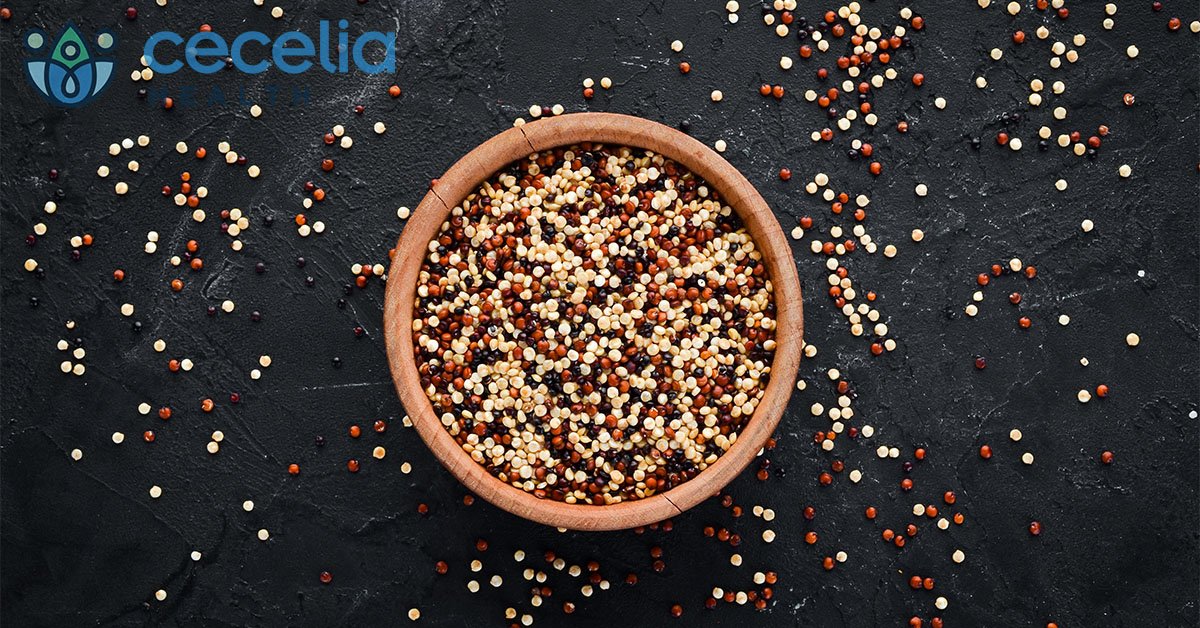Quinoa is a seed that has become very popular there past years. The main reason being that is a complete protein, high fiber, gluten free, and relatively low glycemic index. Quinoa has a glycemic index of 53, which is considered low. However, this doesn’t mean that is low in carbs and should also be consumed as part of a balanced meal.
For people with diabetes, quinoa can be easily incorporated into a diet as replacement for other foods high in carbohydrates, such as white rice, pasta, or breads.
Types of Quinoa
Most of the quinoa you’ll find at the supermarket comes in white, black or red. However, there is more than 300 varieties of quinoa.
A study examining red, black and white quinoa found that while black quinoa has the lowest fat content, it has the highest omega-3 fatty acid and carotenoid contents. The same study analyzed the antioxidant content of each time and found that the darker the color, the higher the antioxidant capacity.
Nutritional Profile
Contains all nine essential amino acids:
This seed contains all nine essential amino acids making it a complete protein (one of the best to consume). It’s like having chicken but more nutritious and in form of a plant.
Contains less carbohydrates than rice:
In addition to protein, it contains a reduced amount of carbohydrates and is high in fiber, vitamins (including B vitamins) and is rich in vital minerals such as iron, calcium, and potassium.
Contains plant-fighting compounds called quercetin, a powerful antioxidant:
Quinoa is also rich in indispensable fatty acids and antioxidants. Quercetin, a powerful antioxidant found in quinoa has been shown to have anti-viral and anti-cancer properties.
It is a naturally gluten- free grain:
For people that need to follow a gluten free diet due to Celiac disease of gluten sensitivity, quinoa is free of gluten.
Quinoa is rich in magnesium
Quinoa is high in many nutrients, one being magnesium which is particularly prevalent in this seed.
Magnesium is a mineral that is actively involved with cell signaling, nerve impulses, muscle relaxation, and maintaining a normal heart rhythm.
This mineral also useful for helping to regulate and control blood sugar levels. Experts have found a direct link between magnesium deficiencies and type-2 diabetes.
Therefore, by increasing your daily magnesium intakes, you are better able to improve your rates of insulin sensitivity and regulate your blood sugar levels.
Here are more nutrients quinoa is rich in:
- Antioxidants
- Protein
- Fiber
- Folate
- Manganese
- Phosphorous
- Vitamin B1
How to make quinoa:
In just 20 minutes, you can have a superfood prepared at home and the best part – it doesn’t need a chef to make it tasty! Here are 7 steps to make the perfect quinoa at home:
- Place 1 cup raw quinoa in a mesh strainer.
- Rinse under the faucet, submerging quinoa and shaking to wash away residue.
- Shake remaining water out of quinoa in the strainer and dump rinsed quinoa into a medium pot.
- Add 2 cups water and ½ tsp salt. Bring to a boil.
- Cover pot and reduce heat, simmering for 15 minutes or until water is absorbed.
- Remove from heat and leave covered for 5 minutes.
- Fluff quinoa with a fork and serve.
How to add quinoa to your diet for diabetes
Here are some simple ways you can add quinoa to a balanced diet to help manage blood sugars.
- Replace quinoa for rice
- Add it to salads and seasonal vegetables
- Make breakfast porridge
- Combine it with beans
- Look for bread made from quinoa
